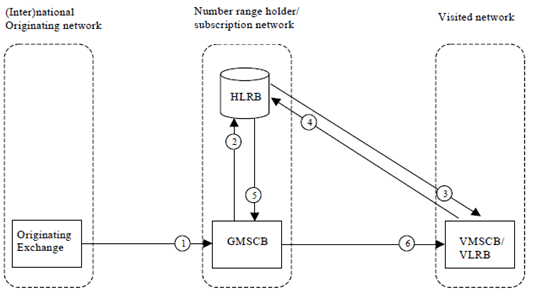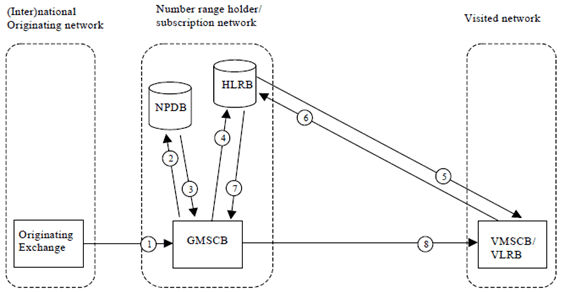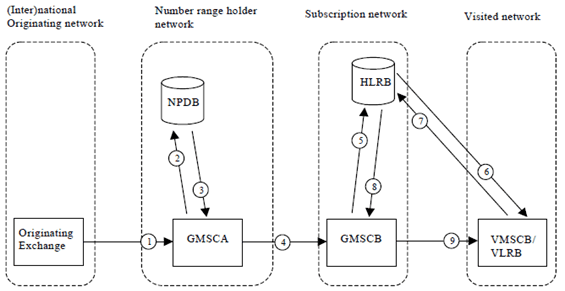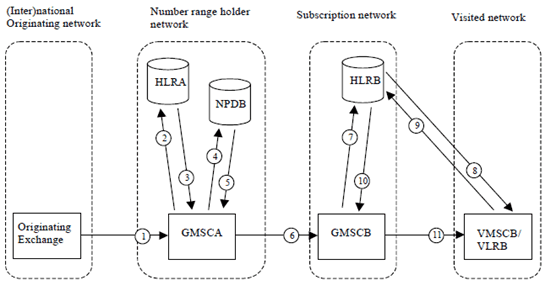Content for TS 23.066 Word version: 18.0.0
A IN Call-Related Technical Realisation
A.1 Architecture
A.1.1 Network Options
A.1.2 No NP Query required - Number is not subject for portability
A.1.3 NP Query in Number Range Holder Network
A.1.3.1 TQoD - Number is not ported
A.1.3.2 TQoD - Number is ported
A.1.3.3 QoHR - Number is ported
...
...
A (Normative) IN Call-Related Technical Realisation p. 19
A.1 Architecture p. 19
A.1.1 Network Options p. 19
There are two IN-based solutions for querying the NPDB:
sent when roaming in their home PLMN and directed to ported and non-ported mobile subscribers, depending on whether or not the called and the calling subscriber subscribe to the same PLMN.
- ETSI Core INAP
- ANSI IN Query.
- Terminating call Query on Digit Analysis (TQoD);
- Query on HLR Release (QoHR).
- Originating call Query on Digit Analysis (OQoD).
A.1.2 No NP Query required - Number is not subject for portability p. 19
Figure A.1.2 shows the architecture for a call to a number that is not subject for portability. This can be for several reasons like for example:
the national regulator has stipulated some number series as being non-portable or;
in an initial phase only a limited amount of subscribers might port in certain number blocks and some operators might want to treat the call routeing according to traditional routeing plans without any change.

- From an Originating Exchange a call is set up to MSISDN. The call is routed to the Number range holder network being the Subscription network.
- When GMSCB receives the ISUP IAM, it requests routeing information by submitting a MAP SRI to the HLRB including the MSISDN in the request.
- The HLRB requests an MSRN from the MSC/VLRB where the mobile subscriber currently is registered;
- The MSC/VLRB returns an MSRN back to the HLRB.
- The HLRB responds to the GMSCB by sending an SRI ack with an MSRN.
- GMSCB uses the MSRN to route the call to VMSCB.
A.1.3 NP Query in Number Range Holder Network p. 20
A.1.3.1 TQoD - Number is not ported p. 20
Figure A.1.3.1 shows the architecture for a call where the Originating network has no knowledge whether the MSISDN is ported or not and uses the traditional routeing plans for routeing the call to the Number range holder network for further routeing decisions.

- From an Originating Exchange a call is set up to MSISDN. The call is routed to the Number range holder network being the Subscription network.
- When GMSCB receives the ISUP IAM, it will send a database query to the NPDB as a result of analysis of the received MSISDN. The MSISDN is included in the query to the NPDB.
- The NPDB detects that the MSISDN is not ported and responds back to the GMSCB to continue the normal call setup procedure for MT calls.
- The GMSCB requests routeing information by submitting a MAP SRI to the HLRB, including the MSISDN in the request.
- The HLRB requests an MSRN from the MSC/VLRB where the mobile subscriber owning the MSISDN currently is registered.
- The MSC/VLRB returns an MSRN back to the HLRB.
- The HLRB responds to the GMSCB by sending an SRI ack with an MSRN.
- GMSCB uses the MSRN to route the call to VMSCB.
A.1.3.2 TQoD - Number is ported p. 21
Figure A.1.3.2 shows the architecture for a call where the Originating network has no knowledge whether the MSISDN is ported or not and uses the traditional routeing plans for routeing the call to the Number range holder network for further routeing decisions.

- From an Originating Exchange a call is set up to MSISDN. The call is routed to the Number range holder network.
- When GMSCA receives the ISUP IAM, it will send a database query, including the MSISDN, to the NPDB as a result of analysis of the received MSISDN.
- The NPDB detects that the MSISDN is ported and responds back to the GMSCA with a Routeing Number pointing out the Subscription network.
- The call is routed to the Subscription network based on the Routeing Number carried in ISUP IAM message; also the MSISDN is included in IAM.
- The GMSCB requests routeing information by submitting a MAP SRI to the HLRB, including the MSISDN in the request. The capability to route messages to the correct HLR is required.
- The HLRB requests an MSRN from the MSC/VLRB where the mobile subscriber currently is registered.
- The MSC/VLRB returns an MSRN back to the HLRB.
- The HLRB responds to the GMSCB by sending an SRI ack with an MSRN.
- GMSCB uses the MSRN to route the call to VMSCB.
A.1.3.3 QoHR - Number is ported p. 22
Figure A.1.3.3 shows the architecture for a call where the Originating network has no knowledge whether the MSISDN is ported or not and uses the traditional routeing plans for routeing the call to the Number range holder network for further routeing decisions.

- From an Originating Exchange a call is set up to MSISDN. The call is routed to the Number range holder network.
- When GMSCA receives the ISUP IAM, it requests routeing information by submitting a MAP SRI to the HLRA including the MSISDN in the request.
- The HLRA returns a MAP SRI ack with an "Unknown Subscriber" error since no record was found for the subscriber in the HLRA.
- When GMSCA receives the error indication form the HLRA, this will trigger the sending of a database query to the NPDB, including the MSISDN in the query.
- The NPDB detects that the MSISDN is ported and responds back to the GMSCA with a Routeing Number pointing out the Subscription network.
- The call is routed to the Subscription network based on the Routeing Number carried in ISUP IAM message; also the MSISDN is included in IAM.
- The GMSCB requests routeing information by submitting a MAP SRI to the HLRB, including the MSISDN in the request. The capability to route messages to the correct HLR is required.
- The HLRB requests an MSRN from the MSC/VLRB where the mobile subscriber currently is registered.
- The MSC/VLRB returns an MSRN back to the HLRB.
- The HLRB responds to the GMSCB by sending an SRI ack with an MSRN.
- GMSCB uses the MSRN to route the call to VMSCB.